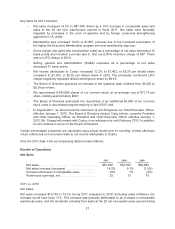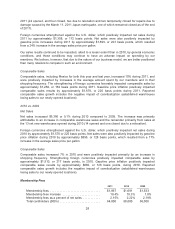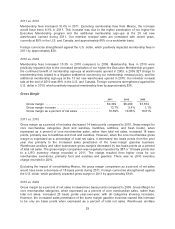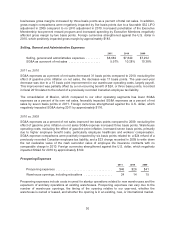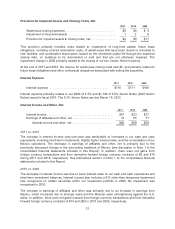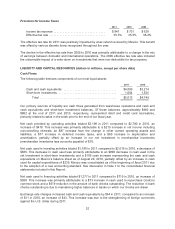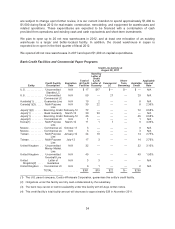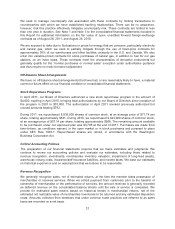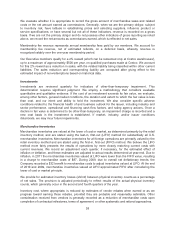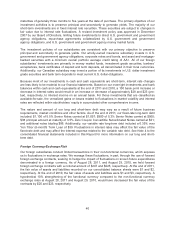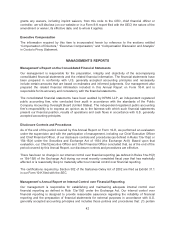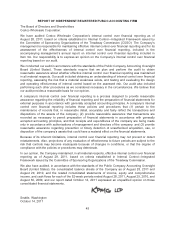Costco 2011 Annual Report Download - page 38
Download and view the complete annual report
Please find page 38 of the 2011 Costco annual report below. You can navigate through the pages in the report by either clicking on the pages listed below, or by using the keyword search tool below to find specific information within the annual report.
In April 2010, our Japanese subsidiary paid the outstanding principal and interest balances totaling $44
related to the 0.92% promissory notes due April 2010, originally issued in April 2003.
In June 2008, our Japanese subsidiary entered into a ten-year term loan in the amount of $39, with a
variable rate of interest of Yen TIBOR (6-month) plus a 0.35% margin (0.79% and 0.84% at the end of
2011 and 2010, respectively) on the outstanding balance. Interest is payable semi-annually in
December and June and principal is due in June 2018.
In October 2007, our Japanese subsidiary issued promissory notes through a private placement in the
amount of $85, bearing interest at 2.695%. Interest is payable semi-annually, and principal is due in
October 2017. We guarantee all of the financial instruments issued by our Japanese subsidiary.
In February 2007, we issued $900 of 5.3% Senior Notes due March 15, 2012 (2012 Notes) at a
discount of $2 and $1,100 of 5.5% Senior Notes due March 15, 2017 (2017 Notes) at a discount of $6
(together the 2007 Senior Notes). Interest on the 2007 Senior Notes is payable semi-annually on
March 15 and September 15 of each year. The discount and issuance costs associated with the 2007
Senior Notes are being amortized to interest expense over the terms of those notes. At our option, we
may redeem the 2007 Senior Notes at any time, in whole or in part, at a redemption price plus accrued
interest. The redemption price is equal to the greater of 100% of the principal amount of the 2007
Senior Notes to be redeemed, or the sum of the present values of the remaining scheduled payments
of principal and interest to maturity. Additionally, we will be required to make an offer to purchase the
2007 Senior Notes at a price of 101% of the principal amount plus accrued and unpaid interest to the
date of repurchase, upon certain events as defined by the terms of the 2007 Senior Notes.
In August 1997, we sold $900 principal amount at maturity 3.5% Zero Coupon Convertible
Subordinated Notes (Zero Coupon Notes) due in August 2017. The Zero Coupon Notes were priced
with a yield to maturity of 3.5%, resulting in gross proceeds to the Company of $450. The remaining
Zero Coupon Notes outstanding are convertible into a maximum of 878,000 shares of Costco Common
Stock at an initial conversion price of $22.71. Holders of the Zero Coupon Notes may require us to
purchase the Zero Coupon Notes (at the discounted issue price plus accrued interest to date of
purchase) in August 2012. At our option, we may redeem the Zero Coupon Notes (at the discounted
issue price plus accrued interest to date of redemption) any time after August 2002. As of August 28,
2011, $862 in principal amount of Zero Coupon Notes had been converted by note holders into shares
of Costco Common Stock, of which the principal converted during 2011, 2010 and 2009 is detailed in
the table below:
2011 2010 2009
Principal converted during period .......................... $ 3 $ 1 $ 25
Principal converted, including the related debt discount ........ $ 2 $ 1 $ 19
Shares issued upon conversion (000’s) ..................... 65 18 562
Derivatives
We are exposed to foreign currency exchange-rate fluctuations in the normal course of business. We
manage these fluctuations, in part, through the use of forward foreign-exchange contracts, seeking to
economically hedge the impact of fluctuations of foreign-exchange on known future expenditures
denominated in a foreign currency. The contracts are intended primarily to economically hedge our
exposure to U.S. dollar merchandise inventory expenditures made by our international subsidiaries or
other entities whose functional currency is other than the U.S. dollar. Currently, these contracts do not
qualify for derivative hedge accounting. We seek to mitigate risk with the use of these contracts and do
not intend to engage in speculative transactions. These contracts do not contain any credit-risk-related
contingent features.
36



